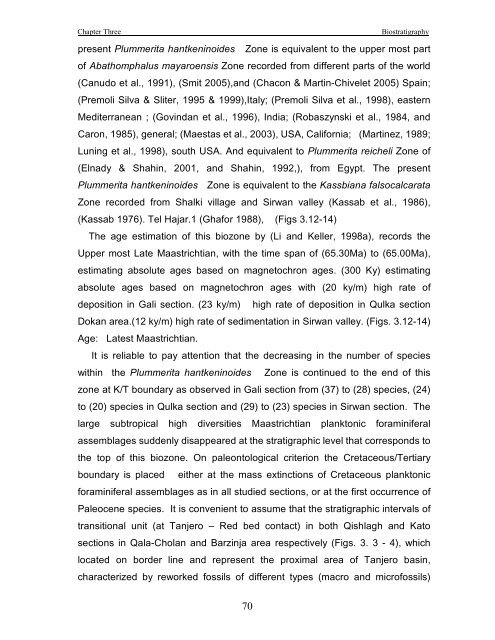biostratigraphy and paleoecology of cretaceous/tertiary boundary in ...
biostratigraphy and paleoecology of cretaceous/tertiary boundary in ...
biostratigraphy and paleoecology of cretaceous/tertiary boundary in ...
Create successful ePaper yourself
Turn your PDF publications into a flip-book with our unique Google optimized e-Paper software.
Chapter Three Biostratigraphy<br />
present Plummerita hantken<strong>in</strong>oides Zone is equivalent to the upper most part<br />
<strong>of</strong> Abathomphalus mayaroensis Zone recorded from different parts <strong>of</strong> the world<br />
(Canudo et al., 1991), (Smit 2005),<strong>and</strong> (Chacon & Mart<strong>in</strong>-Chivelet 2005) Spa<strong>in</strong>;<br />
(Premoli Silva & Sliter, 1995 & 1999),Italy; (Premoli Silva et al., 1998), eastern<br />
Mediterranean ; (Gov<strong>in</strong>dan et al., 1996), India; (Robaszynski et al., 1984, <strong>and</strong><br />
Caron, 1985), general; (Maestas et al., 2003), USA, California; (Mart<strong>in</strong>ez, 1989;<br />
Lun<strong>in</strong>g et al., 1998), south USA. And equivalent to Plummerita reicheli Zone <strong>of</strong><br />
(Elnady & Shah<strong>in</strong>, 2001, <strong>and</strong> Shah<strong>in</strong>, 1992,), from Egypt. The present<br />
Plummerita hantken<strong>in</strong>oides Zone is equivalent to the Kassbiana falsocalcarata<br />
Zone recorded from Shalki village <strong>and</strong> Sirwan valley (Kassab et al., 1986),<br />
(Kassab 1976). Tel Hajar.1 (Ghafor 1988), (Figs 3.12-14)<br />
The age estimation <strong>of</strong> this biozone by (Li <strong>and</strong> Keller, 1998a), records the<br />
Upper most Late Maastrichtian, with the time span <strong>of</strong> (65.30Ma) to (65.00Ma),<br />
estimat<strong>in</strong>g absolute ages based on magnetochron ages. (300 Ky) estimat<strong>in</strong>g<br />
absolute ages based on magnetochron ages with (20 ky/m) high rate <strong>of</strong><br />
deposition <strong>in</strong> Gali section. (23 ky/m) high rate <strong>of</strong> deposition <strong>in</strong> Qulka section<br />
Dokan area.(12 ky/m) high rate <strong>of</strong> sedimentation <strong>in</strong> Sirwan valley. (Figs. 3.12-14)<br />
Age: Latest Maastrichtian.<br />
It is reliable to pay attention that the decreas<strong>in</strong>g <strong>in</strong> the number <strong>of</strong> species<br />
with<strong>in</strong> the Plummerita hantken<strong>in</strong>oides Zone is cont<strong>in</strong>ued to the end <strong>of</strong> this<br />
zone at K/T <strong>boundary</strong> as observed <strong>in</strong> Gali section from (37) to (28) species, (24)<br />
to (20) species <strong>in</strong> Qulka section <strong>and</strong> (29) to (23) species <strong>in</strong> Sirwan section. The<br />
large subtropical high diversities Maastrichtian planktonic foram<strong>in</strong>iferal<br />
assemblages suddenly disappeared at the stratigraphic level that corresponds to<br />
the top <strong>of</strong> this biozone. On paleontological criterion the Cretaceous/Tertiary<br />
<strong>boundary</strong> is placed either at the mass ext<strong>in</strong>ctions <strong>of</strong> Cretaceous planktonic<br />
foram<strong>in</strong>iferal assemblages as <strong>in</strong> all studied sections, or at the first occurrence <strong>of</strong><br />
Paleocene species. It is convenient to assume that the stratigraphic <strong>in</strong>tervals <strong>of</strong><br />
transitional unit (at Tanjero – Red bed contact) <strong>in</strong> both Qishlagh <strong>and</strong> Kato<br />
sections <strong>in</strong> Qala-Cholan <strong>and</strong> Barz<strong>in</strong>ja area respectively (Figs. 3. 3 - 4), which<br />
located on border l<strong>in</strong>e <strong>and</strong> represent the proximal area <strong>of</strong> Tanjero bas<strong>in</strong>,<br />
characterized by reworked fossils <strong>of</strong> different types (macro <strong>and</strong> micr<strong>of</strong>ossils)<br />
70

















